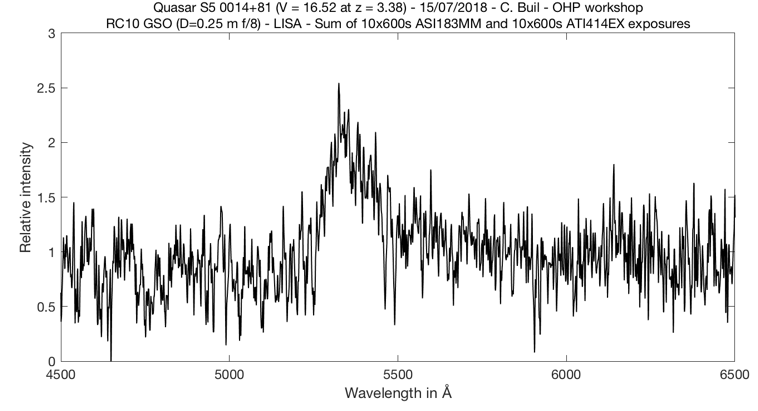J014709+463037
The quad gravitational lensed quasar
By Christian Buil
July 2018

The observation is made during the annual spectrographic OHP workshop. Left the setup: A 10-inch f/8 Ritchey-Chretien telescope and a LISA spectrograph + CMOS ASI183MM (ZWO). At the second plane, the C9.25 telescope + Lhires III spectrograph operated by Valerie Desnoux.

A short bibliography about this spectacular recently discovered object (the Andromeda’s parachute) at z=2.377 and nearly V=15.5 for the principal components:
2D-spectrum of the quasar before sky removal with the typical sky background at Observatoire de Haute-Provence (but during the 5 first acquisition the moon is present in the sky). The LISA is equipped with a long slit (35 microns width = 3.5 arcsec on the sky). The exposure time is 11 x 900 s.

The 2D-spectrum of the quasar after sky removal procedure:

The extracted spectral profile (ISIS software) and indentification of some spectrale lines:

Detail of blue / UV region:

Left, field images of the quad quasar. LISA guiding camera (ZWO ASI1600MM).

During the same workshop session, the quasar S5 0014+81 is also observed (AD=00H17’08.47’’, DEC=+81°35’08.13’’ (2000)). The object, nearly at z = 3.38 (distant of more 12 billion light-years), is more faintest (V=16.52). I use two different cameras (for comparison studies), a CMOS model (ASI183MM) and a CCD model (ATIK414EX). The presented spectrum is the sum of the two results. At the center, the Lyman α (at rest wavelength 1217.7 A) is measured at 5346 A. The Lyman forest is well visible at the shorted wavelength side of Lyman α line.

The RC10 telescope in action during the 2018 OHP spectro workshop:
